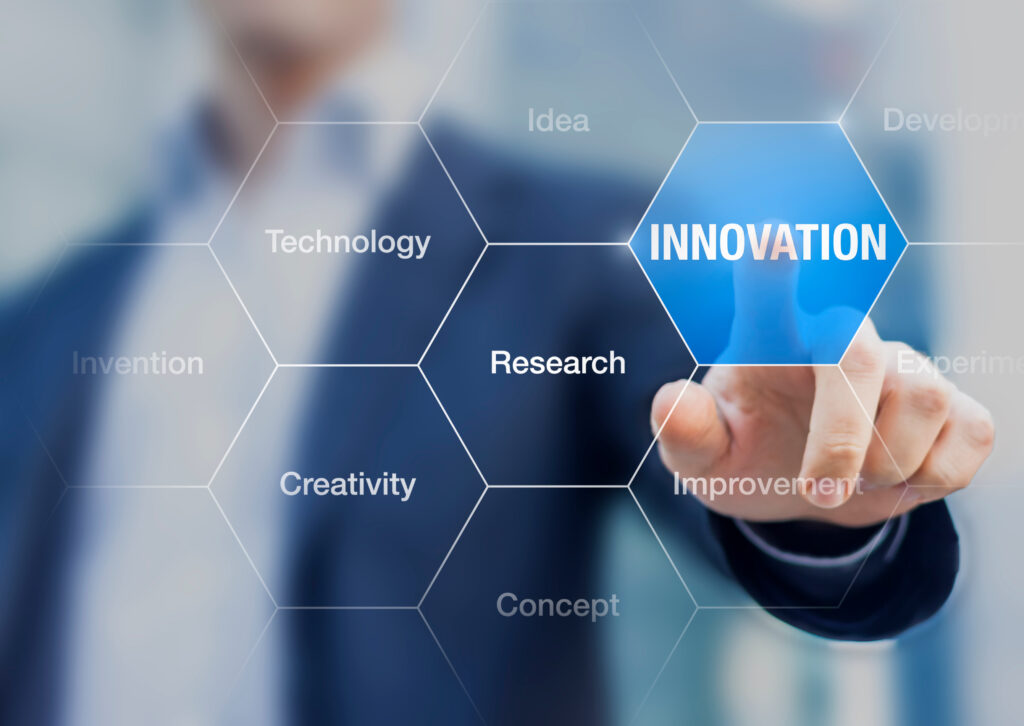Creativity and innovation are essential for success today. Innovation is the driver of business growth, but there’s little guidance on how to make it happen.
However, using a research-supported and practice-tested process, it’s not only feasible but likely that you and your team can design new products and services around which a successful business can be created.
The innovation process consists of four distinct stages:
1. The generation of new problems and opportunities
2. The conceptualization of new, potentially useful ideas
3. The optimization of solutions
4. The implementation of the new solutions
Let’s look at each one individually.
1. Generating new problems and opportunities
Generating is the stage that involves getting the innovation process rolling. This involves the proactive acquisition and generation of new information and possibilities and the sensing of trends, opportunities, and problems. Generative thinking requires that you gather information through direct experience, questioning, imagining possibilities, sensing new problems and opportunities, and viewing situations from different perspectives. This stage comprises fact-finding activities.
Generating ideas relies on the principle of deferring judgment as you create a number of ideas. For example, utilizing a brainstorming technique allows you to come up with ideas for meeting your chosen problem by casting a wide net and producing a multiple number of ideas. Another technique, “blitzing,” blows up an idea into many more specific ideas, giving a single idea several modifications. If, for example, you were looking to improve a child’s car seat, you might dissect the idea of examining what materials are used.
2. Conceptualizing new, potentially useful ideas
Conceptualizing keeps the innovation process going. Like generating, it involves divergence, but rather than gaining understanding by direct experience, it favors gaining understanding by abstract thinking. It results in putting new ideas together, formulating and discovering insights that help define problems, and creating theoretical models to explain things.
This stage may involve generating an altogether new problem to solve and it conceptualizes new challenges and ideas. The focus is on making good decisions through listening objectively to one another in order to come up with the most creative end result. Effective conceptualizing gives sound structure to fledging ideas and opportunities.
3. Optimizing solutions
Optimizing moves the innovation process further along. Like conceptualizing, it favors gaining understanding by abstract thinking. But rather than diverge, it entails converting abstract ideas and alternatives into practical solutions and plans.
In this stage, problem-solving, evaluation, and selection take place through healthy discussion. This includes addressing the realities needed to get an idea to market by engaging in idea evaluation, idea selection, and action planning. It also entails realizing as the development of new solutions takes place that even the best products will have specific challenges in getting to market.
4. Implementing the new solutions
Implementing completes the innovation process. Like optimizing, it favors converging. However, unlike optimizing, it favors learning by direct experience rather than abstract thinking. This leads to getting things done by solution implementation.
Implementers must now physically test things out rather than mentally test them. At the same time, implementing requires adapting quickly to immediately changing circumstances to ensure the product or service gains traction on the market.
While effective innovation requires strong performance in each of the four stages of the creative process, oftentimes, individuals or teams prefer some stages over others. This means that teams comprised of diverse members will outperform teams made up of members with basic similarities. Further, team members who respectfully challenge and question each other’s positions make more informed and creative decisions on the path to market credibility.
All four stages of the process require creativity of different kinds, and each contributes uniquely to the overall innovation process. By combining and blending styles, entrepreneurs can capitalize on team members’ different orientations and turn the journey to market into a satisfying experience.
Threads: The Happy Hour of Professional Networking(Opens in a new browser tab)
* * *
Min Basadur is a Professor Emeritus of Innovation at McMaster University, Canada, and founder of Basadur Applied Creativity. Michael Goldsby is Stoops Distinguished Professor of Entrepreneurship and Chief Entrepreneurship Officer at Ball State University. Rob Mathews is the Executive Director of the Entrepreneurial Leadership Institute at Ball University. Their new book, Design-Centered Entrepreneurship, Second Edition (Routledge, 2022), provides a research-driven, step-by-step approach to creative problem-solving. Learn more at https://elprofile.com/.
By Min Basadur, Michael Goldsby and Rob Mathews
